
Draba lactea, the Lapland whitlow-grass or milky whitlow-grass, is a flower common throughout the high Arctic. It stretches further south in mountainous areas of Norway, Montana, and Canada.

Draba aizoides is a species of Draba, known as yellow whitlow-grass. It is native to Europe where it is found on limestone rocks and walls. In the British Isles it is found only on the Gower peninsula.

Draba verna the spring draba, shadflower, nailwort, common whitlowgrass, vernal whitlow grass, early witlow grass or whitlow-grass is a species of plant in the mustard family, Brassicaceae. D. verna has the unique trait of bifid petals, not found anywhere else in the genus Draba. The plant consists of a few flowers with branching stems and the leaves are focused around the base of the plant. The seeds are located in the flower but are not equipped with any sort of wind dispersal adaptation.

Heteranthera limosa is an annual flowering plant in the water hyacinth family known by the common names ducksalad and blue mudplantain. It grows in shallow water or on mud. It is considered a threatened species in parts of the central United States, and an invasive species weed in California, where it is a nuisance in rice paddies. It is also occasional in Florida waterways.

Empetrum nigrum, crowberry, black crowberry, or, in western Alaska, blackberry, is a flowering plant species in the heather family Ericaceae with a near circumboreal distribution in the northern hemisphere. It is also native in the Falkland Islands. It is usually dioecious, but there is a bisexual tetraploid subspecies, Empetrum nigrum subsp. hermaphroditum, that occurs in more northerly locations and at higher altitude.
Draba albertina is a species of flowering plant in the mustard family known as slender draba or slender whitlow-grass. This plant is native to western North America, where it grows at high elevations from Arizona to Alaska and northern Canada. Like many species of Draba, it can grow in alpine and Arctic climates. This is a biennial or short-lived perennial with a single stem or several branching stems which may be very short or up to 40 centimeters in height. The appearance of the plant varies depending on the climate it endures. The leaves are up to 4 centimeters long, roughly hairy, and mostly basal. The stem bears an inflorescence of up to about 30 small yellow flowers. The fruit is a silique up to two centimeters long.

Draba aureola is a species of flowering plant in the family Brassicaceae known as the Mt. Lassen draba or Mt. Lassen whitlow-grass. This plant is native to the Cascade Range of western North America, where it grows at elevations above 2000 meters. This is usually a perennial plant found growing in rocky areas such as volcanic cliffs and scree. It has one or more short, stout stems which are covered in stiff hairs. The leaves grow in a dense basal clump at the ground. They are fat and fleshy and covered in a carpetlike coat of stiff, light colored branching hairs. The stem may be erect above the clump of leaves or its inflorescence may rest directly upon them. The spherical or club-shaped inflorescence may have up to 80 small yellow flowers packed densely in it, each petal about 5 millimeters wide. The fruit is a wavy-edged, hairy silique about a centimeter long and half a centimeter wide.

Draba cuneifolia is a species of flowering plant in the family Brassicaceae known as the wedgeleaf draba or wedgeleaf whitlow-grass. This annual plant is native to the southern half of North America where it grows in open, rocky fields and disturbed areas. The plant forms a basal cluster of leaves, which are thick, widely toothed, and coated in stiff hairs. It bolts one or more erect stems which may approach 40 centimeters in maximum height. Each hairy stem bears an inflorescence of up to 75 small white flowers that continue at intervals down the stem as the stem grows in height. At fruiting the stem is lined with many fruits on stalks, which are flat, green siliques up to a centimeter long.
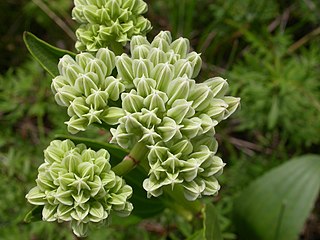
Arnoglossum plantagineum also known as tuberous Indian-plantain, groovestem Indian plantain or Prairie Indian plantain, is a North American species of Arnoglossum in the sunflower family. he Latin specific epithet plantagineum refers to the leaves of the plant which are similar to those of a plantain.

Liatris elegans, known commonly as pinkscale gayfeather, pinkscale blazingstar, and elegant blazingstar, is a species of flowering plant in the aster family, Asteraceae. It is native to the southeastern United States as far west as Texas and Oklahoma.
Draba breweri is a species of flowering plant in the family Brassicaceae known by the common names cushion draba, Brewer's draba, and Brewer's Whitlow grass. With Draba cana now considered a variety of this species, it is distributed throughout parts of northern and western North America, including much of Canada and the western United States. The less widespread var. breweri is limited to mountainous California and western Nevada.
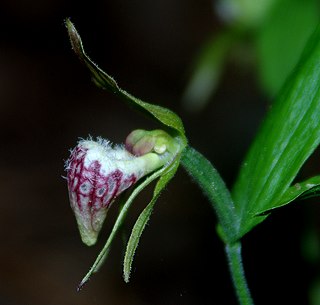
Cypripedium arietinum, the ram's head lady's slipper, is a rare orchid that grows in lightly shaded areas with calcareous soils. It is characteristic of the alvars around the Great Lakes in North America, as well as in New England. In Canada, it is found from Quebec to Saskatchewan, plus an isolated population in Nova Scotia, where it grows on gypsum based soils, 330 km away from the nearest population in Maine.

Arenaria norvegica, also known as Arctic, English or Norwegian sandwort, is a low growing plant in the family Caryophyllaceae, found in northwest Europe. The chromosome number is 2n=80. There are two recognised subspecies.

Artemisia norvegica is a species of flowering plant in the aster family known by the common names alpine sagewort, boreal sagewort, mountain sagewort, Norwegian mugwort, arctic wormwood, and spruce wormwood. It is found in cold locations in Eurasia and high altitudes and high latitudes in North America.
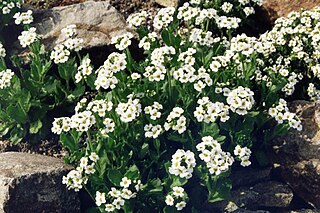
Draba fladnizensis is a species of plant in the family Brassicaceae known by the common names arctic draba, Austrian draba, and white arctic whitlow-grass. It has a circumpolar distribution, occurring throughout the northern latitudes of the Northern Hemisphere. It is present in Europe, Asia, and North America from Alaska across northern Canada to Greenland. Its distribution extends south through the higher elevations in the Rocky Mountains to Colorado and Utah. It is common and widespread in the Canadian Arctic Archipelago, occurring on several Arctic islands including Baffin, Devon, and Ellesmere Islands. It is named after the Austrian village of Flattnitz, in the Gurktaler Alpen.

Agalinis auriculata is a species of flowering plant in the family Orobanchaceae known as earleaf false foxglove, auriculate false foxglove, and earleaf gerardia. It is endemic to the United States, where it occurs from New Jersey west to Minnesota and throughout most southern states.

Draba longisiliqua, the long-podded whitlow grass, is a species of flowering plant in the family Brassicaceae, native to the Caucasus. Despite its common name, it does not resemble, nor is it related to, the true grasses. It is a low-growing evergreen perennial growing to 9 cm (4 in) tall by 25 cm (10 in) wide, forming a cushion of hairy grey leaves with masses of yellow flowers in spring. It is usually grown in an alpine house or scree bed, as it requires excellent drainage and protection from winter wet. The plant is also known to thrive in tufa. It has gained the Royal Horticultural Society's Award of Garden Merit.
Arnica lonchophylla is a species of flowering plant in family Asteraceae. The common names for this species includes longleaf arnica, northern arnica, and spear-leaved arnica. It has daisy-like yellow flowers that are 2.5 to 5 cm across with a yellow center disks.
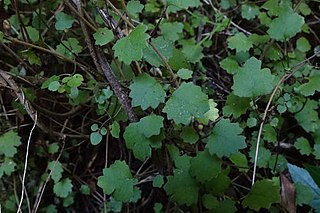
Brachyglottis sciadophila, commonly known as Climbing groundsel, is a flowering plant in the family Asteraceae. It is has long stems with small green leaves and bright yellow flowers. It is the only climbing daisy which has yellow flowers that is endemic to New Zealand
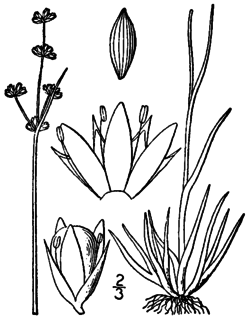
Juncus marginatus is a species of flowering plant, it is a type of rush with the common names of margined rush and grass-leaf rush.

















